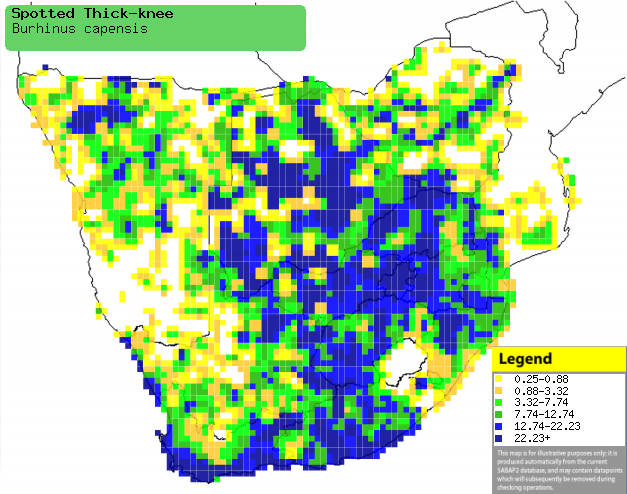|
Burhinus capensis (Spotted
thick-knee, Spotted dikkop)
Gewone dikkop [Afrikaans]; Ingqangqolo (generic term for
thick-knee) [Xhosa]; umBangaqhwa, umJenjana [Zulu]; Eswaita (term used for both
species of dikkop) [Kwangali]; Khoho-ea-lira, Khoalira [South Sotho];
Gwarimutondo [Shona]; Umunkonkoni (generic term for thick-knee) [Swazi];
Mtshikuyana (generic term for dikkop) [Tsonga]; Kgoadirê, Mongwangwa,
Tswangtswang [Tswana]; Kaapse griel [Dutch]; Oedicnème tachard [French];
Kaptriel, Bändertriel [German]; Alcaravão do Cabo [Portuguese]
Life
> Eukaryotes >
Opisthokonta
> Metazoa (animals) >
Bilateria >
Deuterostomia > Chordata >
Craniata > Vertebrata (vertebrates) > Gnathostomata (jawed
vertebrates) > Teleostomi (teleost fish) > Osteichthyes (bony fish) > Class:
Sarcopterygii (lobe-finned
fish) > Stegocephalia (terrestrial
vertebrates) > Tetrapoda
(four-legged vertebrates) > Reptiliomorpha > Amniota >
Reptilia (reptiles) >
Romeriida > Diapsida > Archosauromorpha > Archosauria >
Dinosauria
(dinosaurs) > Saurischia > Theropoda (bipedal predatory dinosaurs) >
Coelurosauria > Maniraptora > Aves
(birds) > Order: Charadriiformes
Distribution and habitat
Although it has isolated populations in the Arabian
Peninsula, the bulk of its population is in sub-Saharan Africa, absent from the
most arid parts of Somalia and the lowland forest of west Africa and DRC. In
southern Africa it
is fairly common across much of the region, largely excluding Lesotho, southern
Namibia and central and northern Mozambique. It generally prefers open habitats,
especially savanna and grassland but also woodland fringes, low stony hills and
urban habitats, such as parks, playing fields and parks.
|
 |
|
Distribution of Spotted thick-knee in southern Africa,
based on statistical smoothing of the records from first SA Bird Atlas
Project (©
Animal Demography unit, University of
Cape Town; smoothing by Birgit Erni and Francesca Little). Colours range
from dark blue (most common) through to yellow (least common).
See here for the latest distribution
from the SABAP2. |
Predators and parasites
- Predators
- Parasites
- Haemoproteus burhini (blood parasite)
- Sarcocystis (tick)
Movements and migrations
Largely resident, although it is a mainly a dry
season (April-December) visitor to Mashonaland, Zimbabwe.
Food
It mainly eats insects, doing most of its foraging in a
plover-like manner, repeatedly running forward, stopping then jabbing prey with
its bill. The following food items have been recorded
in its diet:
- invertebrates
- vertebrates
Breeding
- Monogamous, usually territorial solitary nester, although it occasionally
forms loose colonies. It often rears two or even three broods in a single
breeding season.
- The nest (see images below) is a shallow scrape in the ground, sometimes
unlined but usually with a lining of a few twigs, animal droppings, leaves or stone
chips. It is usually located in grassland, either out in the open or
partially concealed beneath a bush.
- Egg-laying season is from August-April, peaking from September-January.
- It lays 1-3 eggs, which are incubated by both sexes for about 24-30
days.
- The chicks leave the nest within 24 hours of hatching and are fed by
both parents, fledging after about eight weeks in captivity (probably
earlier in the wild). When threatened by a predator the chicks crouch and
remain motionless, while the adults often pretend to have a broken back,
wing or leg to distract it. In years when the adults rear multiple broods,
the chicks usually become fully independent about 10 days after the next
brood hatches.
Threats
Not threatened.
References
-
Hockey PAR, Dean WRJ and Ryan PG 2005. Roberts
- Birds of southern Africa, VIIth ed. The Trustees of the John Voelcker
Bird Book Fund, Cape Town.
|
